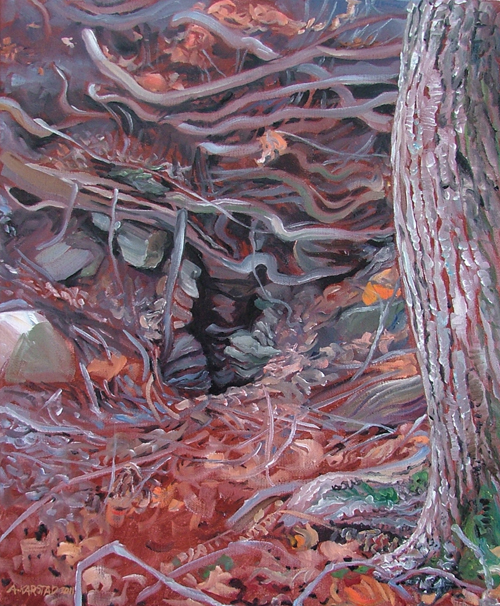Where The Eels Went Into The Ground (oil on canvas 16 x 20 in.) Sold
17 November finds me perched at the base of a tree on the steep side of a short deep ravine surrounded by ploughed fields on Laurier Road north of Casselman, Ontario. I can almost see down into the entrance of a cave - the cave where First Nations people say is "the place where the Eels go into the ground". A creek meanders along the bottom of the ravine and disappears under a tangle of sticks and autumn leaves before the cave mouth. Above that a vertical bank rises 10 metres high, a wall of clay laced across by tree roots.
There's not much moss or foliage there - looks pretty gloomy at this end. There are also another couple of charming scenes in that little ravine, and Fred wanders there collecting twiggy litter from the foot of the slopes including and a few small Arion slugs, one Deroceras reticulatum slug, several living small Anguisira alternata snails, and lots of shells, but no sow bugs. Clear water flows from a culvert under the road - the stream that feeds the cave. Staff at South Nation Conservation tell us that the creek emerges again in a neighbours' field. Raccoon tracks decorate the flat clay sides of the stream - most ground cover frosted Ferns, or Viola pubescens (Yellow Violet) with a few berries of Caulophyllum thalictroides (Blue Cohosh) and scattered plants of a Geum that has richly evergreen-looking leaves. And, of course, a scattering of seedling Rhamnus cathartica (Common Buckthorn) to threaten the future. The woods are Tilia americana (Basswood) Acer negundo (Manitoba Maple) and Fraxinus (Ash) with the major trees being 80-90 cm diameter Basswood.As I paint, thick flakes of the first snow of the year begin to fall, reminding me of the large flock of Snow Geese that we saw when we arrived. They were sitting in the field by the ravine, mixed with a vast flock of Canada Geese, but separated off into their own flock when they all took to the air in a jubilant clamour. These are more Snow Geese than we've ever seen before in eastern Ontario.




Dear Aleta,
ReplyDeleteThe eels here are so camouflaged, it's easy to imagine them hunkering down for the wintertime. Do they really go into caves?
I know I've seen them--the small grass eels--wriggling around park parking lot puddles early spring.
By the way, my address has changed to: .
Hope you're enjoying this late, mild--so far--winter weather.
Cindy
Where have you seen this, Cindy? The whole problem regarding Eels in the Ottawa area is that because of dams on the rivers, we don't have any young ones.
ReplyDeleteYour e-mail address was stripped off. Please send your change of address to my e-mail address.
Before Eels had their heroic migrations to and from the Atlantic broken by dams on the St Lawrence, Ottawa, and South Nation rivers, they used to be wonderfully abundant in eastern Ontario, but now they're a Species at Risk, and the fate we foresaw in a 1990 poem has come to pass, though with more of the decline attributed to the inability to pass dams and other barriers, and less to direct pollution, than anticipated.
ReplyDeleteAnguilla rostrata
I am a balance of life and death and migration:
n less a billion may not be enough
Are you still watching for me?
Am I still here?
Go down to the sunny spring shore to check
Am I still here?
Go down to the silver autumn sound and check
Am I still here?
Where are the salt marshes and the knothole ponds?
Where has Lake Ontario gone?
Where is Kemptville Creek?
Am I still here?
Eels can live anywhere: even in a canal
Eels can live anywhere: even in sewage
Eels can live anywhere: even in a clearcut
Eels can live anywhere: even in a subdivision
Eels can live anywhere: even in a landfill
I am the eternal bounty of the sea washing up onto your shore.
Pickle me in leachate, smoke me with PCB's;
Do not weep for me:
there will be no mitigation when I am gone.
I will be more invisible than leptocephali when I am gone
Black will be the Sargasso depths when I am gone — black as today.
Clear will be the the Atlantic waters — clear as today.
Watch for my death
Watch for my going
Watch for me
Come down to the shore to be sure this spring has come.
As silent as my coming will be the spring when I am gone:
n less a billion may not be enough.
FWS, Bishops Mills, 20 November 1990 - posted by Ted Mosquin at his ecospherics site